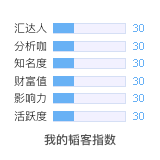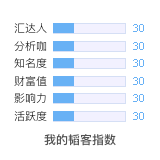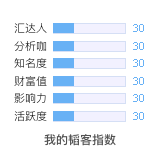[转贴]世界经济面临的风险
The risks ahead for the world economy
Fred Bergsten explains why policymakers need to act now in order to avert the danger of serious damage to the world economy
FIVE major risks threaten the world economy. Three centre on the United States: renewed sharp increases in the current-account deficit leading to a crash of the dollar; a budget profile that is out of control; and an outbreak of trade protectionism. A fourth relates to China, which faces a possible hard landing from its recent overheating. The fifth is that oil prices could rise to $60-70 per barrel even without a major political or terrorist disruption, and much higher with one.
Most of these risks reinforce each other. A further oil shock, a dollar collapse and a soaring American budget deficit would all generate much higher inflation and interest rates. A sharp dollar decline would increase the likelihood of further oil price rises. Larger budget deficits will produce larger American trade deficits, and thus more protectionism and dollar vulnerability. Realisation of any one of the five risks could substantially reduce world growth. If two or three, let alone all five, were to occur in combination then they would radically reverse the global outlook.
There is still time to head off each of these risks. Decisions made in America immediately after this year's elections will be pivotal. China, the new growth locomotive, is key to resolving the global trade imbalances and must play a central role in future. Action by a number of other countries will be essential to maintain global growth and to avoid deeper oil shocks and new trade restrictions.
The most alarming new prospect is another sharp deterioration in America's current-account deficit. It has already reached an annual rate of $600 billion, well above 5% of the economy. New projections by my colleague Catherine Mann (see chart 1) suggest it will now be rising again by a full percentage point of GDP per year, as actually occurred in 1997-2000. On such a trajectory, the deficit would exceed $1 trillion per year by 2010.
There are three reasons for this dismal prospect. First, American merchandise imports are now almost twice as large as exports; hence exports would have to grow twice as fast as imports merely to halt the deterioration. (In the past, such a relationship occurred only after the massive fall experienced by the dollar in 1985-87.) Second, economic growth is likely to remain faster in America than in its major markets and higher incomes there increase demand for imports much faster than income growth elsewhere increases demand for American exports. Third, America's large debtor position (it currently is in the red by more than $2.5 trillion) means that its net investment income payments to foreigners will escalate steadily, especially as interest rates rise.
Of course, it is virtually inconceivable that the markets will permit such deficits to eventuate. The only issue is how they are to be averted. An immediate resumption of the gradual decline of the dollar, as in the period 2002-03, cumulating in a fall of at least another 20%, is needed to reduce the deficits to sustainable levels.
If delayed much longer, the dollar's inevitable fall is likely to be much larger and much faster. Moreover, much of the slack in America's product and labour markets will probably have disappeared in a year or so. Sharp dollar depreciation at that stage would push up inflation and macroeconomic models suggest that American interest rates could even hit double digits.
The situation would be still worse if future increases in energy prices and the budget deficit compound such developments, as they surely could. The negative impact would also be much greater in other countries because of their need to generate larger and faster domestic demand increases in order to offset declining trade surpluses.
Fears of a hard landing for the dollar and the world economy are of course not new. The situation is much more ominous today, however, because of the record current-account deficits and international debt, and the high probability of further rapid increases in both. The potential escalation of oil prices suggests a parallel with the dollar declines of the 1970s, which were associated with stagflation, rather than the 1980s when a sharp fall in energy costs and inflation cushioned dollar depreciation (but still produced higher interest rates and Black Monday for the stockmarket). Paul Volcker, former chairman of the Federal Reserve, predicts with 75% probability a sharp fall in the dollar within five years.
The prospects for the budget deficit and trade protectionism further darken the picture. Official projections score the fiscal imbalance at a cumulative $5 trillion over the next decade, but exclude probable increases in overseas military and homeland-security expenditures, extension of the recent tax cuts and new entitlement increases proposed by both presidential candidates. This deficit could also approach $1 trillion per year (see chart 2), yet there is no serious discussion of how to restore fiscal responsibility, let alone an agreed strategy for reining in runaway entitlement programmes (especially Medicare).
Different deficits
The budget and current-account deficits are not “twin”. The budget in fact moved from large deficit in the early 1990s into surplus in 1999-2001, while the external imbalance soared anew. But increased fiscal shortfalls, especially with the economy nearing full employment, will intensify the need for foreign capital. The external deficit would almost certainly rise further as a result.
Robert Rubin, former secretary of the Treasury, also stresses the psychological importance for financial markets of expectations concerning the American budget position. If that deficit is viewed as likely to rise substantially, without any correction in sight, confidence in America's financial instruments and currency could crack. The dollar could fall sharply as it did in 1971-73, 1978-79, 1985-87 and 1994-95. Market interest rates would rise substantially and the Federal Reserve would probably have to push them still higher to limit the acceleration of inflation.
These risks could be intensified by the change in leadership that will presumably take place at the Federal Reserve Board in less than two years, inevitably creating new uncertainties after 25 years of superb stewardship by Mr Volcker and Alan Greenspan. A very hard landing is not inevitable but neither is it unlikely.
The third component of the “America problem” is trade protectionism. The leading indicator of American protection is not the unemployment rate, but rather overvaluation of the dollar and its attendant external deficits, which sharply alter the politics of trade policy. It was domestic political, rather than international financial, pressure that forced previous administrations (Nixon in 1971, Reagan in 1985) aggressively to seek dollar depreciation. The hubbub over outsourcing and the launching of a spate of trade actions against China are the latest cases in point. The current-account, and related budget, imbalances may not be sustainable for much longer, even if foreign investors and central banks prove willing to continue funding them for a while.
The fourth big risk centres on China, which has accounted for over 20% of world trade growth for the past three years. Fuelled by runaway credit expansion and unsustainable levels of investment, which recently approached half of GDP, Chinese growth must slow. The leadership that took office in early 2003 ignored the problem for a year. It has finally adopted a peculiar mix of market-related policies, such as higher reserve requirements for the banks, and traditional command-and-control directives, such as cessation of lending to certain sectors. The ultimate success of these measures is highly uncertain.
Under the best of circumstances, China's expansion will decelerate gradually but substantially from its recent 9-10% pace. When the country cooled its last excessive boom after 1992, growth declined for seven straight years. A truly hard landing could be much more abrupt and severe. Either outcome will, to a degree, counter the inflationary and interest-rate consequences of the other global risks. But a slowdown, and especially a hard landing, in China would sharply reinforce their dampening effects on world growth.
The fifth threat is energy prices. In the short run, the rapid growth of world demand, low private inventories, shortages of refining and other infrastructure (particularly in America), continued American purchases for its strategic reserve and fears of supply disruptions have outstripped the possibilities for increased production. Hence prices have recently hit record highs in nominal terms. The impact is extremely significant since every sustained rise of $10 per barrel in the world price takes $250 billion-300 billion (equivalent to about half a percentage point) off annual global growth for several years. Mr Greenspan frequently notes that all three major post-war recessions have been triggered by sharp increases in the price of oil.
My colleague Philip Verleger concludes that this lethal combination could push the price to $60-70 per barrel over the next year or two, perhaps exceeding the record high of 1980 in real terms. Gasoline prices per gallon in America would rise from under $2 now to $2.60 in 2006. Prices would climb even more if political or terrorist events were further to unsettle production in the Middle East, the former Soviet Union or elsewhere.
Curtail the cartel
The more fundamental energy problem is the oligopolistic nature of the market. The OPEC cartel in general, and dominant supplier Saudi Arabia in particular, restrict supply in the short run and output capacity in the long run to maintain prices far above what a competitive market would generate. They do not always succeed and indeed have suffered several sharp price falls over the past three decades. They are often unable to counter excessive price escalation when they want to, as at present.
Primarily due to the cartel, however, the world price has averaged about twice the cost of production over the past three decades. The recent price above $40 per barrel compares with production charges of $15-20 per barrel in the highest-cost locales and much lower marginal costs in many OPEC countries. This underlying problem also looks likely to get worse, as the Saudis have talked openly about increasing their target range from the traditional $22-28 per barrel to $30-40.
There is a high probability that one or more of these risks to global prosperity and stability will eventuate. The consequences for the world economy of several of them reinforcing each other are potentially disastrous. All five risks can be avoided, however, or their adverse effects at least substantially dampened, by timely policy actions. The most important single step is for the president of the United States to present and aggressively pursue a credible programme to cut the federal budget deficit at least in half over the coming four years and to sustain the improvement thereafter. This will require a combination of spending cuts, revenue increases and procedural changes (including the restoration of “PAYGO” rules in Congress), as well as rapid economic growth.
Such a programme would maximise the prospects for maintaining solid growth in America and the world by avoiding the crowding out of private-sector investment and by reducing the likelihood of higher interest rates. It would represent the best insurance against a hard landing via the dollar, by buttressing global confidence in the American economy. It should be feasible, having been more than accomplished during the 1990s. Its absence would virtually assure realisation of at least some of the inter-related global risks within the next presidential term.
An energy stability pact
America and its allies must also move decisively on energy. Sales from their strategic reserves, which total about 1.3 billion barrels (including 700m in the United States), would reverse the recent price increases for at least a while and demonstrate a willingness to counter OPEC. For the longer run, America must expand production (including in Alaska) and increase conservation (especially for motor vehicles). Democrats and Republicans must together take the political heat of establishing a gasoline, carbon or energy tax that will limit consumption, help protect the environment and reduce the need for future military interventions abroad.
The most effective “jobs programme” for any American administration and the world as a whole, however, would be an initiative to align the global oil price with levels that would result from market forces. America should therefore seek agreement among importing countries (including China, India and other large developing importers as well as industrialised members of the International Energy Agency) to offer the producers an agreement to stabilise prices within a fairly wide range centred at about $20 per barrel.
Consumers would buy for their reserves to avoid declines below the floor of the range and sell from those reserves to preserve its ceiling. A sustained cut of $20 per barrel in the world price could add a full percentage point to annual global growth for at least several years. The resultant stabilisation of price swings would avoid the periodic spikes (in both directions) that tend to trigger huge economic disruption. Producers would benefit from these global economic gains, from their new protection against sharp price falls and from trade concessions that could be included in the compact to help them diversify their economies.
China must also play a central role in protecting the global outlook. Fortunately, it can resolve its internal overheating problem and contribute substantially to the needed global rebalancing through the single step of revaluing the renminbi by 20-25%. Such a currency adjustment would simultaneously address all of China's domestic troubles: dampening demand (for its exports) by enough to cut economic growth to the official target of 7%; countering inflation (now approaching double digits for inter-company transactions) directly by cutting prices of imports; and checking the inflow of speculative capital that fuels monetary expansion.
A sizeable renminbi revaluation is also crucial for global adjustment because much of the further fall of the dollar needs to take place against the East Asian currencies. These have risen little if at all, although their countries run the bulk of the world's trade surpluses. China has greatly intensified the problem by maintaining its dollar peg and riding the dollar down against most other currencies, further improving its competitiveness. Other Asian countries, from Japan through India, have thus intervened massively to keep their currencies from appreciating against the dollar (and, with it, against the renminbi). This has severely limited correction of the American deficit and thrown the corresponding surplus reduction on to Europe and a few others with freely flexible exchange rates. China should reject the US/G-7/IMF advice to float its currency, which is far too risky in light of its weak banking system and could even produce a weaker renminbi, and opt instead for a substantial one-shot revaluation. It should in fact take the lead in working out an “Asian Plaza Agreement” to ensure that all the major Asian countries make their necessary contributions to global adjustment.
Countries that undergo currency appreciation, and thus face reductions in their trade surpluses, will need to expand domestic demand to sustain global growth. China need not do so now because it must cool its overheated economy. But the other surplus countries, including Japan and the euro area, will have to implement structural reforms and new macroeconomic policies to pick up the slack. America and the surplus countries should also work together to forge a successful Doha round, renewing the momentum of trade liberalisation and reducing the risks of protectionist backsliding.
Risk in our times
The global economy faces a number of major risks that, especially in combination, could throw it back into rapid inflation, high interest rates, much slower growth or even recession, rising unemployment, currency conflict and protectionism. Even worse contingencies could of course be envisaged: a terrorist attack with far larger economic repercussions than September 11th or a sharp slowdown in American productivity growth, as occurred after the oil shocks of the 1970s, that would further undermine the outlook for both economic expansion and the dollar.
Fortunately, policy initiatives are available that would avoid or minimise the costs of the most evident risks. America will be central to achieving such an outcome and the president and Congress will have to decide in early 2005 whether to address these problems aggressively or simply avert their eyes and hope for the best, taking major risks with their own political futures as well as with the world economy. China will have to play a new and decisive leadership role. The major oil producers and the other large economies must do their part. The outlook for the global economy for at least the next few years hangs in the balance.
发表于:2004-09-20 00:52只看该作者
2楼
早上好! [em35] [em35]













